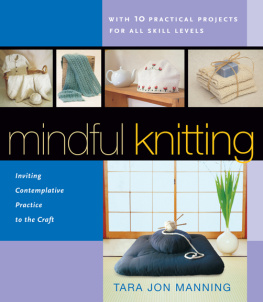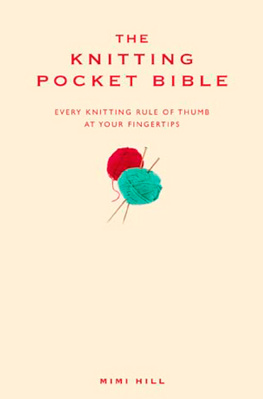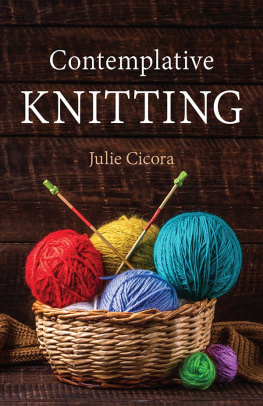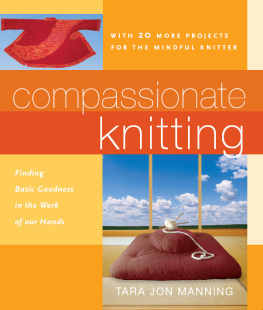THANKS TO THE VERBLE CHGYAM TRUNGPA RINPOCHE for manifesting the vision, and to the Sakyong Mipham Rinpoche and Shambhala International for holding
and moving it forward into the twenty-first century.
Thanks to Ani Pema Chdrn for saying it all in a way that everyone can understand.
Thanks to my parents for following their path to the Dharma and bringing me with them.
Thanks to Bill, Jack, and Zane for constantly renewing my understanding of the depths of true love.
Thanks to Joan Anderson for her insight, support, and foudroyance.
Thanks to Linda Roghaar and the Linda Roghaar Literary Agency for seeing the delight in the idea, unending support and encouragement.
Thanks to Jennifer Lantagne and Tuttle Publishing, Lori Gayle, Lynn Gates, the manufacturers and distributors who graciously supplied the materials, and to all the knitters who know the essence of mindfulness found on the needles.
HOW DOES ONE BEGIN to be mindful? Can being mindful really affect how we perceive the world? Absolutely! Mindfulness simply means engaging in what is happening from moment-to-moment, allowing ourselves to be aware of what is occurring in our minds and in our surroundings without judgment or interpretationsimply as an onlooker. As we purposefully elicit a state of mindful awareness, we begin to experience a peaceful, balanced state. In cultivating this preciousness in our experience, we become more and more anchored in our body and in the present moment, fostering a clear and calm state of being. Practicing mindfulness gives us the opportunity to develop a renewed and kind sense of who we are, naturally encouraging our self-confidence to grow.
Contemplative or mindful activities are any that allow us to practice mindfulness. These activities provide the circumstances for our minds to rest in the present. For some people this may be an activity such as prayer, for others it is gardening, yoga, or meditation. All these activities have a very important component in commonan object of focus that empowers us to retreat from our thoughts and feelings back to the sanctuary of our still and relaxed place. The object of focus for the simple mindfulness meditation instruction given in this book is the natural flow of breath. The object of focus for the mindful knitter is the repeated formation of the knitted stitch.
basic mindfulness meditation
The mindfulness activities and mindfulness meditation presented in this book are based on my experience of Tibetan Buddhism and the teachings of Chgyam Trungpa Rinpoche (1939 1987) and his eldest son, Sakyong Mipham Rinpoche. Trungpa Rinpoche, an esteemed meditation master and teacher in the traditions of the Kagy and Nyingma lineages of Tibetan Buddhism, was elemental in bringing the teachings of Buddhism to Western students. Sakyong Mipham Rinpoche is head of the Shambhala Buddhist lineage and spiritual director of Shambhala International. Among the principles embraced by Shambhala Buddhism are the notions of innate human wisdom and basic goodness. The understanding and experience of these principles are deepened through the practice of mindfulness meditation.
The very basic form of mediation presented here involves the technique of sitting still in an upright posture and using the tool of focusing ones attention on the flow of breath. This technique is based on the basic sitting meditation instruction known in Shambhala Buddhism as Shamatha. It is a very elemental form of being still, making friends with yourself, and connecting with the richness available in your basic experience. Its also the core technique taught in the Shambhala Training program. Formal instruction in mindfulness meditation in the Shambhala tradition places a good deal of emphasis on the quality of discipline in the form. What this means is that you are encouraged to take this seriously. Keep your posture tall, hold your focus, and feel the connection with your innate dignity that begins to arise.
This form of basic mindfulness meditation can be done by anyone, anywhere, anytime, with no special supplies or gadgets. It does not ask anyone to relinquish any belief or buy into new ones; rather it allows you to explore the beliefs you hold close and engage more precisely in the world around you.
The first component of this meditation is creating a placewithin yourself, within your day, within your lifewhere you can simply be still and quiet. Traditionally, a special place is designated for sitting meditation. You are encouraged to designate a clean, comfortable spot away from distraction where you can relax. In Buddhist and Shambhala traditions, a shrine or altar is placed in this space, not as something to worship or pray to but as a reminder to uplift your state of mind and experience. It often holds objects or photographs that inspire you. A little shrine in your meditation area can be anything you want it to be. It might simply be a little table with a candle and some flowers, or it could hold a photograph of a landscape or an individual important to you. I simply light a candle and burn some subtle incense when I engage in sitting mediation. The ritual of lighting the candle brings me a sense of presence and attention to the activity in which I am about to engage. It also nicely demarcates the beginning and end of my mediation session, allowing my focus to transition more easily from daily activity to my own quiet time, and back again.
Attention to your posture in meditation is very important. The traditional posture for meditation is to sit on the ground with your legs crossed, your back straight and your gaze loosely resting in front of you. When you sit on the ground or floor, you are literally grounded. As you hold your back straight, you are extending your awareness both downward to the earth and upward to heaven, symbolically connecting the two and assuming your place in the world. This upright posture encourages your mind to be fully present in your body. Meditators often use meditation cushions, called zabutons and zafus . The zabuton is a rectangular flat cushion about thirty-six inches square. Upon the zabuton sits the zafu, a round cushion upon which one sits cross-legged. Many seats and cushions in all shapes, variations, and sizes are available, and you can try out different forms of cushions and seating. However, no special seating is actually required. You can practice this basic form of meditation while sitting in a chair, on the couch, or even lying down if necessary. Having reminders of why you are doing this around you is helpful, but having the right attitude is all you really need to get started.
Clearing out a quiet moment for yourself to try this basic technique in the midst of your daily routine can be wonderfully soothing. If you try to meditate when you are feeling antsy or slouchy, you may find that your mind is just too revved up and you may fight against yourself. That might simply not be the right time to try. Instead, keep your very important date with yourself by taking a walk or simply enjoying some quiet time with a cup of tea. In contrast, you may find that when everything is coming together, you have a session where your mind and body are feeling in synch. You are able to hold your posture and your focus and you may notice a natural equilibrium that begins to come through. Neither of these experiences is good or bad. Please remember to be kind and gentle with yourself. What is most important is that you keep with it; dont judge your experiences, but simply notice them and allow them to contrast one against another. The more you do this, the more you will find that you can be increasingly gentle with yourself. You may find clarity in situations that may have previously been confusing or scary.















